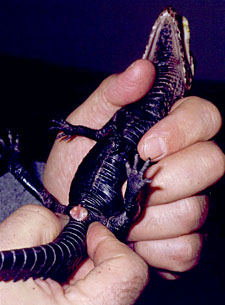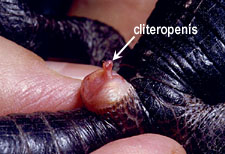
 Figure 9.6. Holding a crocodilian upside down like this usually causes muscle relaxation. The head is restrained gently with one hand, leaving the other free to perform the procedure. Figure 9.6. Holding a crocodilian upside down like this usually causes muscle relaxation. The head is restrained gently with one hand, leaving the other free to perform the procedure.
 Figure 9.7. A dwarf caiman being popped by bending the tail gently upwards and applying pressure to either side of the vent. You can see the cliteropenis emerging from the vent. You can see that the tail does not need bending very far for the method to work. Figure 9.7. A dwarf caiman being popped by bending the tail gently upwards and applying pressure to either side of the vent. You can see the cliteropenis emerging from the vent. You can see that the tail does not need bending very far for the method to work.
 Figure 9.8. A close-up of the vent being popped by gently bending the tail upwards and applying pressure on either side of the vent. In this case, the animal is clearly a male - the penis projects some distance above the vent. Figure 9.8. A close-up of the vent being popped by gently bending the tail upwards and applying pressure on either side of the vent. In this case, the animal is clearly a male - the penis projects some distance above the vent.
 Figure 9.9. Although bending the tail upwards is the better method, the animal can also be popped by bending the tail downwards. This stretches the vent and the penis emerges, although it is not as clearly visible as in Fig. 9.8. Figure 9.9. Although bending the tail upwards is the better method, the animal can also be popped by bending the tail downwards. This stretches the vent and the penis emerges, although it is not as clearly visible as in Fig. 9.8.
 Figure 9.10. Larger crocodilians, like this 3.5 ft American alligator, can also be popped. However, once the vent is large enough to insert your finger into, popping becomes redundant. Figure 9.10. Larger crocodilians, like this 3.5 ft American alligator, can also be popped. However, once the vent is large enough to insert your finger into, popping becomes redundant. |
The images on the left illustrate the procedure. Please remember to be gentle with the animal - use common sense and do not apply too much pressure either bending the tail or squeezing the sides of the vent. Hatchlings are fragile and should be treated with care.
It's easier if you hold the animal away from a surface. Hold the animal upside down in one hand (Fig. 9.6) which should cause it to relax. The other hand is now free to bend the tail and spread the vent. You can either bend the tail towards the animal's belly (Fig. 9.7) so that you compress the vent, or you can bend the tail away from the belly so you stretch the vent (Fig. 9.9). The former method is preferable with caimans. Again, use common sense here - don't bend the tail too far or you'll break the poor little guy's back. Next, using your thumb and index finger, pull the vent apart from either side, and then apply pressure to either side of the vent (Fig. 9.7). This takes a little practice, and you might need to shift pressure forwards and backwards until you hit the right spot (with a second person holding the animal you can use both hands which can be a lot easier). What happens is that the vent should start to spread outwards, and then the tip of male's penis should literally pop into view (Fig. 9.8) . If you don't see an obvious cliteropenis like that in Fig. 9.8 then it's much more likely that you've got a female. Don't apply too much pressure - if there is no obvious penis then stop as you almost certainly have a female. The popping method is easier and quicker than probing the vent, and works very well in some species especially caimans, but probing the vent is more reliable when done by an experienced person.
Before you get the urge to rush off and sex your crocs, just bear in mind that it gets a lot easier as the animal gets larger. Unless you have a very good reason to sex a hatchling or juvenile, it's probably better to wait so you can be sure. Conversely, the larger the croc, the greater its ability to object by sinking its teeth into your arm!
There is more information on sexing hatchlings in the following papers: the first refers to A. mississippiensis, which the authors suggest is impossible to sex until the animal is at least several weeks or months old; the second refers to C. porosus and C. johnstoni, which conversely the authors could sex as day-old hatchlings with a accuracy of 95% using the probing technique.
Joanen, T. and McNease, L. (1978). The cloacal sexing method for immature alligators. Proc. Ann. Conf. S.E. Assoc. Fish & Wildl. Agencies 32: 179-181
Webb, G.J.W., Manolis, S.C. and Sack, G.C. (1984). Cloacal sexing of
hatchling crocodiles. Australian Wildlife Research 11, p.201-202

The flared tip of a spectacled caiman's penis. |